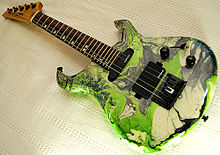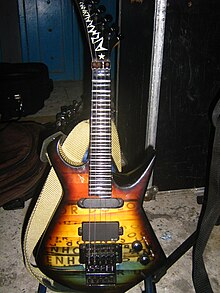Bahian guitar
This article has multiple issues. Please help improve it or discuss these issues on the talk page. (Learn how and when to remove these template messages)
|


The Bahian guitar in
cavaco, 6 String versions (adding on a Low F) also exist.[1]
History
The Bahian guitar evolved from the so-called "electric log", developed in the early 1940s by Adolfo "Dodô" Nascimento and Osmar Álvares Macêdo, in
Mandocaster
), the "Electric Log" constitutes the eldest known solid-body electric mandolin. Until its invention, North American developers had not applied the principle of solid or almost-solid bodies to mandolins to the same extent as they had to guitars. The Bahian guitar was also the first headless solid-body electric plucked instrument, and nowadays it is usually manufactured to resemble a miniature electric guitar.
Carnival usage
The Bahian guitar is intimately connected to the
Electric trio
" tradition (especially on a space-restricted environment), which since then became the single most important trademark of the Bahia/Brazilian street carnival.
References
- ISBN 978-85-85426-44-6. Retrieved 11 April 2011.
- ^ "Guitarra Baiana", MixingABand.com
External links
- Guitarra Baiana at Plate to Plate (archived GeoCities page)
- Guitarra Baiana Archived 1 February 2016 at the Wayback Machine Guitarra Baiana.
